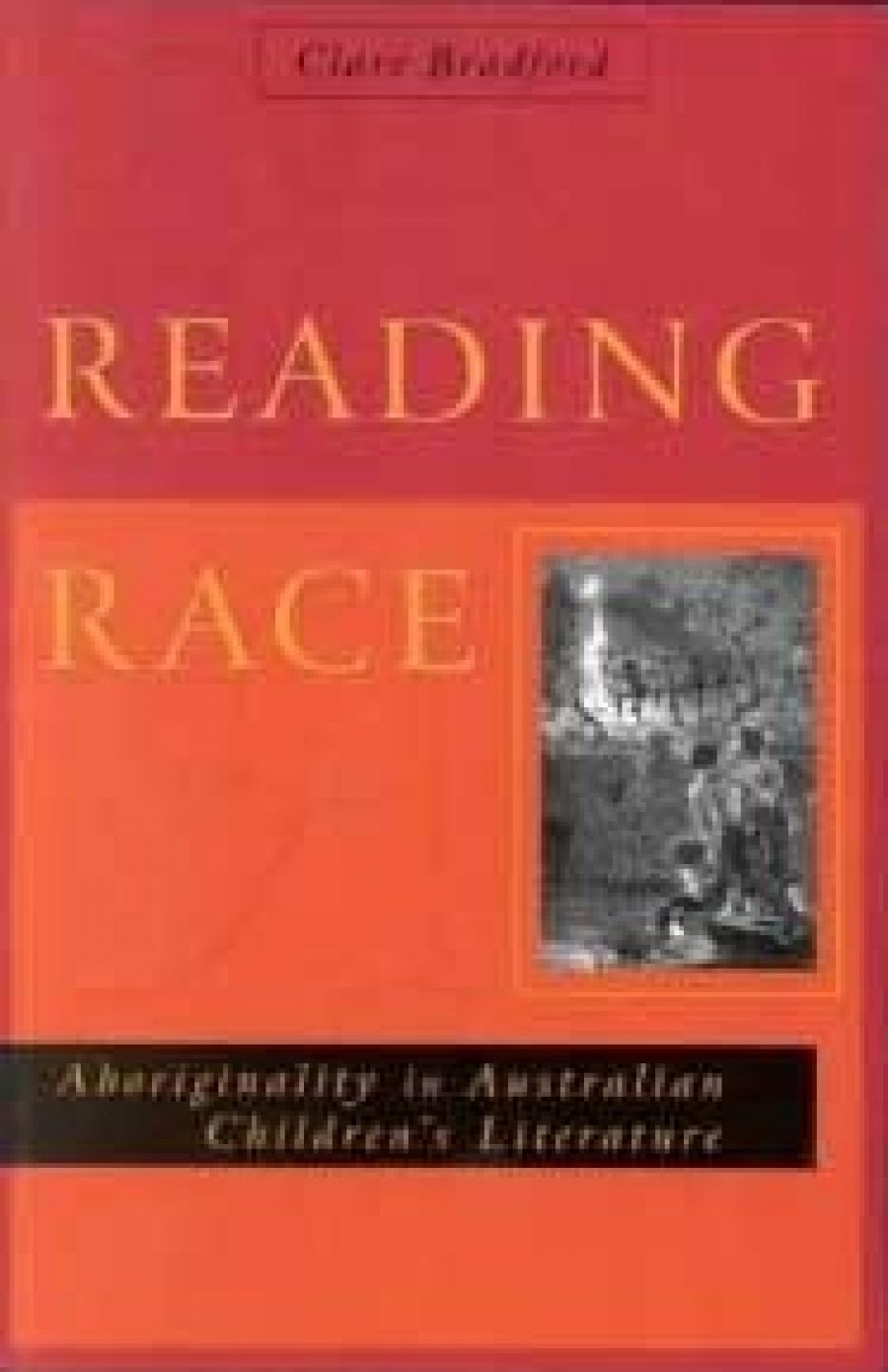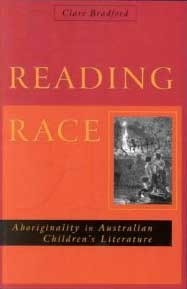
- Free Article: No
- Contents Category: Literary Studies
- Review Article: Yes
- Article Title: Involuted Meanings
- Online Only: No
- Custom Highlight Text:
Clare Bradford is an Associate Professor in Literary and Communication Studies at Deakin University. She writes from within her discipline, and addresses other academics. Reading Race, despite its broad title, is principally a discussion of forms of racism that the author identifies in books published in colonial times, compared with contemporary examples.
- Book 1 Title: Reading Race
- Book 1 Subtitle: Aboriginality in Australian children's literature
- Book 1 Biblio: Melbourne University Press, $38.95, 283 pp
- Book 1 Cover Small (400 x 600):

- Book 1 Cover (800 x 1200):

This curious blindness extends to the important shifts in authorial voices during the 1960s and 1970s, when Nan Chauncy’s Tangara, Colin Thiele’s The Fire in the Stone, James Vance Marshall’s Walkabout and David Martin’s Hughie (among many other titles by these and other authors) were published, as well as the autobiographical Stradbroke Dreamtime of Kath Walker (Oodgeroo) and the first Dreaming legends told and illustrated by traditional owners (e.g. Joe Nangan’s Dreaming). Instead, the author leaps forward to publications of the last decade, after a cursory mention of Chauncy’s Mathinna’s People which ignores its historical significance, and several extensive diatribes on the racism which she sees as informing all of Patricia Wrightson’s work. She categorises Wrightson as an ‘Aboriginalist’, a term she defines as ‘knowledgeable and sympathetic experts who speak about and for Aborigines’ and characterised by ‘a see-sawing of reverence and contempt’. Aboriginalists are her favourite quarry, and include such writers as Kate Langloh Parker, Rex Ingamells and John Marsden. Bradford casts doubt on the value of Wrightson’s speech at the 1978 International Board on Books for Young People conference, when she explained what she was trying to do in incorporating Aboriginal folk creatures into her novels. She even doubts the sincerity of Jack Davis’s response. But I was at that conference, and sitting beside Davis at the time. The air was indeed electric. We all felt we had experienced one of those moments when something shifts in space and time. This was, of course, more than twenty years ago, when Wrightson was working on her epic ‘Wirrun’ trilogy. She was attempting something no one else had tried before, and doing it with sensitivity and respect.
My own bibliography, Black in Focus, identifies me as an ‘Aboriginalist’ as well, on the grounds that my annotations are ‘romantic discourses … with Aboriginality always associated with positive qualities’. If she had read the introduction, she would have learned that the book was the result of a plea by a group of Murri women, who desperately wanted a selection tool that would help them to find books that presented Aboriginality in positive terms, for inclusion in the libraries of the schools their children attended. The criteria I used were Lorna Lippman’s in her groundbreaking ‘Cultural Bias in Primary Textbooks’, published in 1981.
Reading Race is not arranged chronologically even within themes, but rather weaves back and forth between colonial and post-colonial texts, many of which reappear in several different discussions. A few contemporary writers (John Marsden, James Moloney, Phillip Gwynne, Melissa Lucashenko) are given priority treatment, though there are curious gaps. For example, Bradford discusses the issues raised in Moloney’s Angela but ignores the two earlier titles in the trilogy. An examination of the author’s shift in focus within the series might have been informative.
Despite her avowal that her ‘concern is to investigate how children’s texts position their readers in regard to Aboriginality’, Bradford too often loses sight of the reader, especially within the context of the reader as part of a social structure. Thus, when she criticises Maureen McCarthy’s Cross My Heart for presenting Aboriginal characters as ‘stereotypes’ (wise woman, political activist), she is unaware that, for the young urban teenagers whom the book addresses, these characters are not stereotypes but present a fresh, new contrast to the accepted stereotypes of Aboriginals as drunk, shiftless, ignorant etc. The story’s plot, she states, ‘allows for the introduction of a relatively reductive set of ideas about colonialism and environmentalism’. As an invitation for emerging adults to think about these issues, why not? Reviewing the picture book About this little devil and this little fella (Albert Barunga, Stephen Muecke, illustrated by Julie Dowling) Bradford waxes lyrical: ‘Dowling’s deployment of the Flinstones reference and of the “happy darky” stereotype do not function simply as reversions of particular instances of popular culture, but interrogate discourses of race.’ I do not think these sophisticated intellectual references would mean anything to a young child who would simply see another Disneyfied cartoon of a happy darkie – and a positive reinforcement of any similar racist image, forget the ‘interrogated discourses’. A danger within ivory towers is that the rarefied atmosphere distances the inhabitants from the real world, as well as ascribing sometimes extraordinarily involuted meanings to quite simple, straightforward texts.
Despite the dense technicality of the text, I found the chapter ‘Towards Reconciliation? Crosscultural Encounters in the 1990s’ the most perceptive, and a useful background for teachers presenting Aboriginal issues in school curricula. Bradford has researched her limited material with care, and I suspect with an eye to the overseas academic market. Within that context, this should prove a valuable addition to the often-undervalued field of children’s literature.


Comments powered by CComment